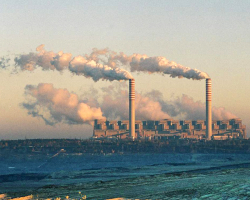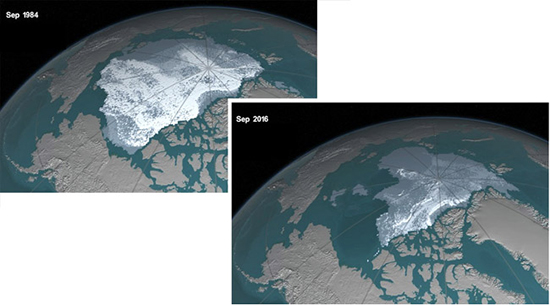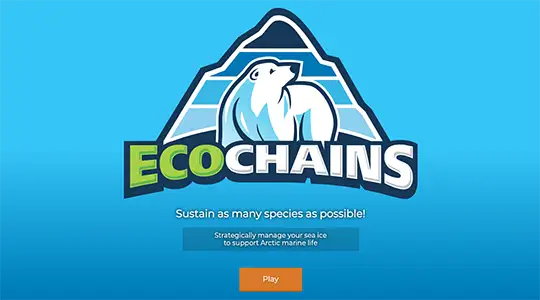Arctic Climate Change

As you walk toward the glacier, it’s almost as if you are looking at a giant. The huge mass of compressed snow and ice is so large that it forms its own landscape. It has rolling ice hills, creeks of icy cold water, and fissures that drop away to darkness.
This glacier is loved by those who live near it, and by those who travel from far away to see it with their own eyes. In the unseasonably warm summer air, you witness part of the glacier's collapse. Under the bright summer sun, the glacier cracks, then cracks again, and then again. With booming crashes, massive sections of ice fall away into the ocean. The ice front, where the glacier meets the sea, retreats back as the glacier shrinks.
Fast Change in the Arctic

The Arctic’s ecosystem has changed quite a bit over the last few decades. The areas around the north and south poles are some of the first places on the planet to show signs of our warming climate. We can see clear evidence of this as glaciers that have been stable for many thousands of years start to melt, and melt fast. As a glacier melts it releases water that has been trapped as ice for thousands of years, causing the sea level to rise all over the world. Besides just warming up, climate change also causes extreme weather events and changes to the ocean.

Scientists and Arctic communities have noticed that there is more open water by the end of summer as sea ice retreats. Many animal species in the Arctic depend on sea ice for hunting food and habitat. When the formation of sea ice happens later in the fall and retreats earlier in the spring, the whole Arctic food web is affected.
Each species plays a role in an environment. If one species goes extinct, the whole ecosystem could be in danger. Even organisms as small as ice algae play a key role in keeping the ecosystem healthy. They provide food for the entire base of the food web.
Species around the world are going extinct at an alarming rate. Some see biodiversity loss as one of the biggest challenges the world is facing. Biodiversity helps clean the air and water, and gives us sources of food and medicine. Slowing climate change will help save many species from extinction.
Carbon and the Climate

So where does climate change even come from? The short answer is, it comes from human activities. We release a lot of carbon dioxide into the air from things that we do, like driving cars, and burning coal or oil to generate power. That extra carbon dioxide holds more heat, which is causing the land and water on Earth to warm. Warming melts snow and ice, and also causes heat waves and changes in rainfall.
But the changes due to carbon dioxide don’t end there. More carbon in the oceans can actually change the water. Extra carbon can make the oceans more acidic. And that acidic water can harm the organisms that live in the ocean.
Keeping Up With Climate Change
Our climate is changing so fast that populations of plants and animals can’t evolve fast enough to keep up and thrive. Climate change doesn’t just threaten plants’ and animals’ way of life, it also threatens humans' way of life. Local Arctic residents, like Indigenous Peoples, are some of those that are most affected. Food sources are much more limited due to species loss, making it harder to get enough food to stay healthy. Many cultures value a connection with nature, but this is now threatened by climate change.

Climate change has a big impact on human and non-human life. It is important to learn more about climate change so that you can play a part in helping species around the world! The EcoChains: Arctic Futures card game is a great place to start.
This section of Ask A Biologist is based upon work supported by the National Science Foundation under Grant No. 1928235.
Additional images from Wikimedia Commons. Global image of melting Arctic ice by NASA, from 2012.
Read more about: Changing Life in the Arctic
Bibliographic details:
- Article: Arctic Climate Change
- Author(s): Dr. Biology
- Publisher: Arizona State University School of Life Sciences Ask A Biologist
- Site name: ASU - Ask A Biologist
- Date published: 27 Jul, 2022
- Date accessed:
- Link: https://askabiologist.asu.edu/arctic-climate-change
APA Style
Dr. Biology. (Wed, 07/27/2022 - 13:13). Arctic Climate Change. ASU - Ask A Biologist. Retrieved from https://askabiologist.asu.edu/arctic-climate-change
Chicago Manual of Style
Dr. Biology. "Arctic Climate Change". ASU - Ask A Biologist. 27 Jul 2022. https://askabiologist.asu.edu/arctic-climate-change
Dr. Biology. "Arctic Climate Change". ASU - Ask A Biologist. 27 Jul 2022. ASU - Ask A Biologist, Web. https://askabiologist.asu.edu/arctic-climate-change
MLA 2017 Style

Arctic sea ice is melting. Notice the difference between the ice shown on the map and yellow border. The yellow marks the average extent of the ice over the last 30 years.
Be Part of
Ask A Biologist
By volunteering, or simply sending us feedback on the site. Scientists, teachers, writers, illustrators, and translators are all important to the program. If you are interested in helping with the website we have a Volunteers page to get the process started.


